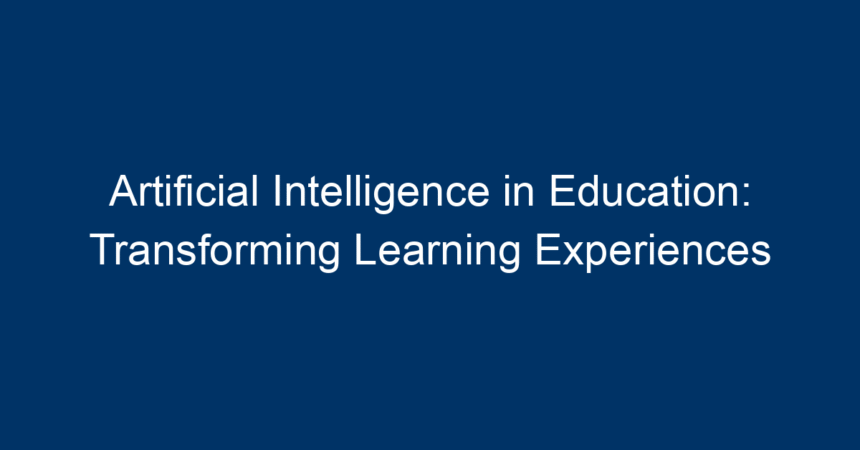In today’s fast-paced digital landscape, the role of technology in education has never been more pivotal. Among these technological advancements, artificial intelligence (AI) in education stands out for its revolutionary impact on teaching and learning experiences. As we delve into this engaging topic, we will explore how AI is reshaping classrooms, enhancing personalized learning, and equipping educators with powerful tools to foster student success.
Understanding Artificial Intelligence in Education
AI refers to the simulation of human intelligence in machines programmed to think and learn. In the context of education, AI systems analyze data, predict outcomes, and provide personalized feedback to students. This innovative technology has opened new avenues for improving learning outcomes, making education more accessible, and streamlining administrative tasks for educators.
The Importance of AI in Education
The integration of AI into education is vital for several reasons:
-
Personalized Learning: Every student learns at a different pace. AI algorithms can assess individual learning styles and needs, paving the way for customized educational experiences.
-
Efficiency: Machine learning can automate administrative tasks, allowing educators to focus more on teaching and engaging with their students.
-
Enhanced Engagement: With AI-driven tools, students often find learning more interactive and enjoyable, which tends to enhance their overall educational experience.
- Access to Resources: AI helps break down geographical barriers by providing quality learning materials and resources to underserved populations across the globe.
The Transformative Benefits of Artificial Intelligence in Education
1. Customized Learning Pathways
One of the most notable ways artificial intelligence in education transforms learning is through customized learning pathways. Traditional education often adopts a one-size-fits-all approach, which fails to meet the diverse needs of learners. AI-powered platforms can analyze a student’s performance and adapt the curriculum accordingly.
For instance, tools like DreamBox and Knewton tailor math lessons based on how well a student grasps concepts, providing targeted exercises that reinforce weak areas. This individualized approach helps students achieve their academic potential and boosts their confidence.
2. Intelligent Tutoring Systems
Intelligent Tutoring Systems (ITS) are AI-powered platforms designed to provide immediate feedback and assistance to learners. These systems can mimic one-on-one tutoring experiences, as they adapt in real-time to a student’s input. For example, Carnegie Learning’s MATHia software uses AI to provide personalized hints and strategies to help students overcome challenging problems.
These systems not only offer personalized assistance but also track student progress, allowing teachers to intervene when necessary, thus ensuring no student is left behind.
3. Enhancing Teacher Efficiency
With busy schedules and multiple responsibilities, educators often struggle to provide personalized attention to each student. AI can help alleviate this challenge by automating grading and administrative tasks. For example, tools like Gradescope streamline the grading process by recognizing patterns in student submissions and providing instant feedback.
Additionally, AI can assist teachers in identifying students who may need extra help or enrichment opportunities. By analyzing data on student performance, AI can highlight trends and help educators make data-driven decisions.
4. Gamification of Learning Experiences
Gamification—integrating game design elements into educational content—has found a new ally in AI. Platforms like Kahoot! and Classcraft leverage AI to create engaging, interactive learning experiences. These tools use data to create challenges tailored to each student’s interests, making learning more fun and effective.
Students are often more motivated when they can learn through games that adapt to their skill level, resulting in higher engagement and improved learning outcomes.
5. Language Learning and AI
AI’s role extends into language learning as well, through platforms such as Duolingo. These applications utilize AI algorithms to offer personalized exercises that adjust based on a learner’s proficiency. The adaptive learning experience helps students practice pronunciation, vocabulary, and grammar in an engaging environment.
Moreover, AI-based chatbots can offer conversational practice outside traditional classroom settings, allowing for more immersive learning experiences.
The Challenges of Implementing AI in Education
While the benefits of artificial intelligence in education are substantial, there are challenges that institutions must address.
1. Data Privacy Concerns
With the increasing reliance on AI, the question of data privacy becomes paramount. Educational institutions must ensure that student data is protected and used ethically. Transparent policies should be in place regarding data collection, storage, and usage to maintain trust among students and parents.
2. Equity and Access
The digital divide remains a pervasive issue in education, where not all students have equal access to technology. Implementing AI in underserved communities can mitigate inequalities in educational opportunities. Policymakers must prioritize funding for technology in schools to ensure that AI benefits all students, regardless of their socioeconomic backgrounds.
3. Resistance to Change
Education is a traditional domain that often resists rapid changes. Some educators may be hesitant to embrace AI due to fears of job displacement or a lack of understanding of how to integrate these technologies effectively into their teaching. Professional development and training programs are essential to help educators navigate this new landscape.
Preparing for the Future: Actionable Insights
1. Invest in AI Training for Educators
Educational institutions should prioritize ongoing professional development that focuses on AI tools. By equipping teachers with the skills to leverage AI in their classrooms, we can ensure a smoother transition to technology-enhanced learning environments.
2. Policy Development for Data Privacy
Administrators must develop clear policies regarding the ethical use of student data. Engaging with stakeholders, including parents and students, can help create trust and transparency around AI initiatives in education.
3. Promote Access to Technology
Investing in infrastructure to ensure equitable access to AI-powered tools is crucial. Collaboration with local governments and organizations can bolster funding efforts for technology in underserved communities.
4. Foster Student Engagement in AI
Encouraging students to collaborate on projects using AI can cultivate interest in technology and critical thinking skills. By being active participants in their education, students will develop a deeper understanding of AI’s applications in their fields.
Conclusion
The integration of artificial intelligence in education is revolutionizing the learning experience for both students and educators. By providing personalized learning pathways, enhancing teacher efficiency, and creating immersive environments, AI stands to impact education profoundly.
However, as we embrace this technological shift, it’s crucial to address the associated challenges to ensure that AI benefits all learners. By fostering equity, protecting data, and equipping educators with the necessary tools, we can create an inclusive, engaging, and effective educational landscape for future generations.
As we look ahead, the intersection of AI and education provides endless possibilities—let us embrace these changes and unlock the full potential of learning in the digital age!




